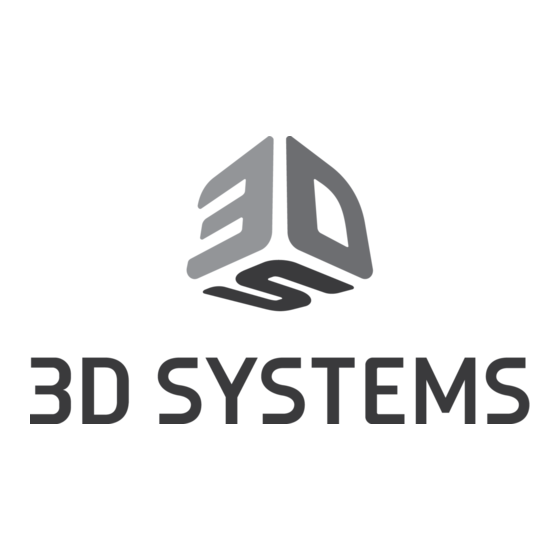Table of Contents
Advertisement
Quick Links
Advertisement
Table of Contents

Summary of Contents for 3D Systems PSLA 270
- Page 1 Post-Processing Guide Release Date: 8/19/2024 Original Instructions...
-
Page 2: Table Of Contents
3.4.1 General Post-Curing Requirements ..........................11 3.4.2 PSLA 270 Material Curing Chart ............................11 3.4.3 PSLA 270 Post-Curing Tips ..............................12 3.5 PSLA 270 Considerations for Heating Figure 4 HI TEMP 300-AMB ..................12 3.6 PSLA 270 Clean Finishing Tools ..............................12 PSLA 270 TROUBLESHOOTING ......................14 3D Systems, Inc. -
Page 3: Psla 270 About This Manual
PSLA 270 ABOUT THIS MANUAL Once your PSLA 270 parts have printed, they are considered "green." That is to say that they are not finished parts yet, and are not safe to touch without 100% nitrile gloves. The parts will not be considered finished and safe to touch until they have been properly cleaned, dried, and fully cured in a UV chamber. -
Page 4: Psla 270 Important Safety Information
PSLA 270 IMPORTANT SAFETY INFORMATION Safety Symbols and Definitions Hot Surface: Parts may be hot when handling. Avoid contact. Allow surface to cool before touching. Hazardeous Material: INDICATES THAT SKIN OR EYE IRRITATION COULD RESULT WHILE EXPOSED TO A CHEMICAL COMPOSITION Wear Protective Gloves: WEAR THE APPROPRIATE GLOVES WHEN REQUIRED. - Page 5 If breathing is difficult, give oxygen and obtain immediate medical attention for the person. See the Facility Requirements guide for information on external-ventilation. Material Handling and Safety For resin handling and safety, please refer to the documents and User Guide for further details. 3D Systems, Inc. p/n 40-D244, Rev. A...
-
Page 6: Psla 270 Post-Processing Instructions
CAUTION: Failure to properly post-process a part not only makes it unsafe to touch, but also can result in part defects. 3.1 PSLA 270 Remove Print Platform and Printed Parts To remove the print platform and printed parts, follow the instructions in the User Guide section Clean Print Platforms. -
Page 7: Manual Cleaning
1. Sonication in IPA - Recommended as a starting point for high-volume, robust cleaning systems. This uses 3D Systems' EZ Rinse C cleaning solvent and IPA from your local supplier. Due to the flammability of IPA, you must use an explosion-proof ultrasonic cleaner. - Page 8 5 wt% in water 3.2.1.3 PSLA 270 When to Change Cleaning Solvents You may change out the cleaning solvent in your containers whenever you feel that the solvent is not doing a good enough job stripping printed parts of uncured resin. However, you may also choose to have a hydrometer on-hand to measure the specific gravity of your solvent/resin mixture.
-
Page 9: Psla 270 Cleaning Parts Using An Ultrasonic Cleaner
EFFECTIVE CHIP GUARDING AND PERSONAL PROTECTIVE EQUIPMENT. FOR ADDITIONAL INFORMATION, GO TO THIS WEBSITE. 3.2.2 PSLA 270 Cleaning Parts Using an Ultrasonic Cleaner Note: Follow all safety precautions and guidelines set forth in the User Guide for the ultrasonic cleaner you have purchased. -
Page 10: Psla 270 Cleaning Parts Manually
30 psi and then only with effective chip guarding and personal protective equipment. The following instructions are recommendations for hand-cleaning parts printed with PSLA 270 resins. 1. Mark containers as Wash and Rinse. -
Page 11: Psla 270 Specific Gravity Measurement
3.2.4 PSLA 270 Specific Gravity Measurement The section PSLA 270 When to Change Cleaning Solvents lists the ranges of specific gravities at different states of your solvent's cleaning life. This section describes specifically how to measure that specific gravity. -
Page 12: Psla 270 Part-Drying Guidelines
Drying oven. This is for sample purposes only, and is not a recommendation or endorsement of any brand of drying oven. 3.3.1 PSLA 270 Part-Drying Guidelines Dry printed parts until you see no more liquid on their surfaces. For any drying method, please use the following guidelines: 1. -
Page 13: Psla 270 Drying Time Quick Reference
3.3.2 PSLA 270 Drying Time Quick Reference No matter which method you use to dry your part, you must ensure it is completely dry before proceeding to the post-curing step. The chart below serves as a quick reference for suggested air-drying times. -
Page 14: Psla 270 Post-Curing Tips
90 minutes. 3.5 PSLA 270 Considerations for Heating Figure 4 HI TEMP 300-AMB Figure 4 HI TEMP 300-AMB creates printed parts that can withstand high temperatures. However, exposure to different temperatures will change the material's color. - Page 15 To clean any of these items, you can either soak them in IPA or place them into a beaker of IPA and put them in an ultrasonic cleaner. Ensure that they are completely dry before their next use. 3D Systems, Inc. p/n 40-D244, Rev. A...
-
Page 16: Psla 270 Troubleshooting
3. Use solvent spray bottle and part- cleaning brush to rid the part of excess resin. 4. If parts are still unfinished after completing 1-3, contact 3D Systems Service. PPI-2 Parts show surface cracks or edge 1. Your particular resin may be erosion during sonication cleaning. - Page 17 2. Use tools such as flat snips and/or tweezers to remove support remnants from tight areas of your part. 3. Perform wet-sanding with IPA on support remnants. 3D Systems, Inc. p/n 40-D244, Rev. A...
- Page 18 3D Systems, Inc. 333 Three D Systems Circle Rock Hill, SC 29730 www.3dsystems.com Register Statement 2024 by 3D Systems, Inc. All rights reserved. Specifications subject to © change without notice. 3D Systems and the 3D Systems logo are registered trademarks of 3D Systems, Inc.

















Need help?
Do you have a question about the PSLA 270 and is the answer not in the manual?
Questions and answers